 The trees are almost bare and the nip of fall is in the air. The sunshine kept us warm while we traversed the balance beam and the log, played toss, rode bikes, hauled loads of dirt in our trucks, dug in the sand, raked leaf piles and threw them up in the air, and set up a toy shop for everyone to purchase their toys with leafy currency.
The trees are almost bare and the nip of fall is in the air. The sunshine kept us warm while we traversed the balance beam and the log, played toss, rode bikes, hauled loads of dirt in our trucks, dug in the sand, raked leaf piles and threw them up in the air, and set up a toy shop for everyone to purchase their toys with leafy currency.




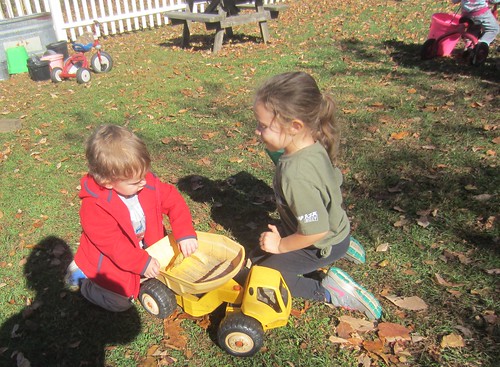








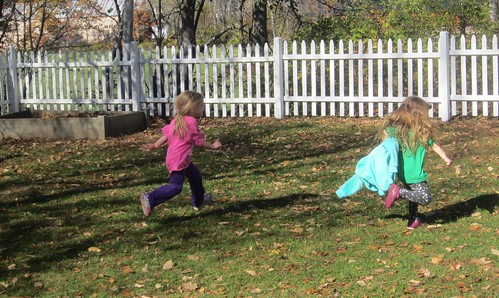
 As seen through the lens by a three-year-old.
As seen through the lens by a three-year-old.





 Monday students listened to the stories Mouse Paint by Ellen Stoll Walsh and Mix It Up by Herve Tullet. We learned that the three primary colors are red, yellow, and blue, and we can create other colors by mixing these together. We then gave it a try, selecting finger paint colors and using our fingers, hands, and even arms to smoosh them together and make new colors.
Monday students listened to the stories Mouse Paint by Ellen Stoll Walsh and Mix It Up by Herve Tullet. We learned that the three primary colors are red, yellow, and blue, and we can create other colors by mixing these together. We then gave it a try, selecting finger paint colors and using our fingers, hands, and even arms to smoosh them together and make new colors.
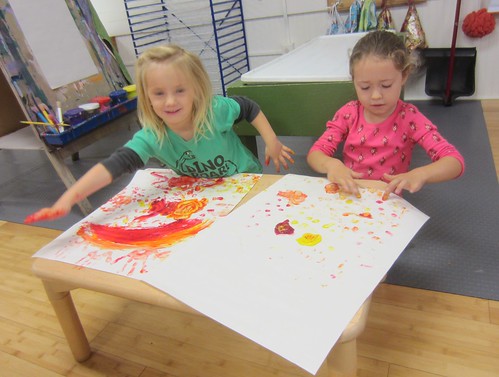

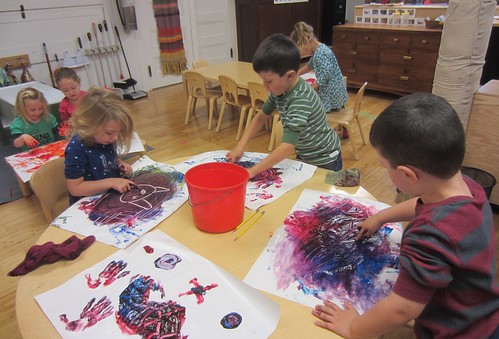


 The partner teams continued to finish up their webs and spiders.
The partner teams continued to finish up their webs and spiders.
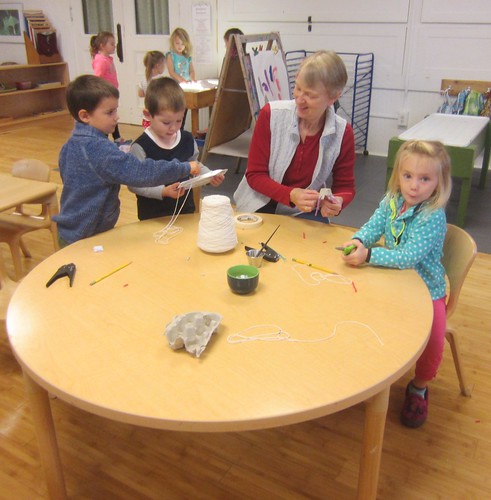
 On Tuesday morning the students were introduced to a sorting and matching activity that was created, cut, and assembled by a student’s grandfather. We laid out the activity on a mat for the students to see what they would each have in their bag, and encouraged them to find different ways to group them. They were then each given a bag of different sized and colored shapes, labelled with a letter from A-Z. There were large and small, red, yellow, and blue triangles, squares, circles, and hexagons. Some of the students very enthusiastically took their shapes to a mat and laid them out, then looked at them to see how they were the same, then decided to sort into piles by color, by shape, and by size.
On Tuesday morning the students were introduced to a sorting and matching activity that was created, cut, and assembled by a student’s grandfather. We laid out the activity on a mat for the students to see what they would each have in their bag, and encouraged them to find different ways to group them. They were then each given a bag of different sized and colored shapes, labelled with a letter from A-Z. There were large and small, red, yellow, and blue triangles, squares, circles, and hexagons. Some of the students very enthusiastically took their shapes to a mat and laid them out, then looked at them to see how they were the same, then decided to sort into piles by color, by shape, and by size.
 After reading Pumpkin Jack, about a boy’s jack-o-lantern that eventually rots and decomposes into soil and grows a new pumpkin plant the following year, we looked at all the parts of a pumpkin. We found the blossom end, where it grew from the blossom on the vine, and located the stem, the rind, and the tendrils. We cut it open to see the pulp, the seeds, and the fibrous strands. We questioned which part of pumpkin Jack would have grown into a new pumpkin plant, and the children all agreed that a seed would have to have been left in the jack-o-lantern to grow into a new plant, otherwise it would just become soil. The children worked on hollowing out the pumpkins, then we took them outside to carve, where everyone who wanted a turn chose an eye, nose, or mouth to help cut out.
After reading Pumpkin Jack, about a boy’s jack-o-lantern that eventually rots and decomposes into soil and grows a new pumpkin plant the following year, we looked at all the parts of a pumpkin. We found the blossom end, where it grew from the blossom on the vine, and located the stem, the rind, and the tendrils. We cut it open to see the pulp, the seeds, and the fibrous strands. We questioned which part of pumpkin Jack would have grown into a new pumpkin plant, and the children all agreed that a seed would have to have been left in the jack-o-lantern to grow into a new plant, otherwise it would just become soil. The children worked on hollowing out the pumpkins, then we took them outside to carve, where everyone who wanted a turn chose an eye, nose, or mouth to help cut out.


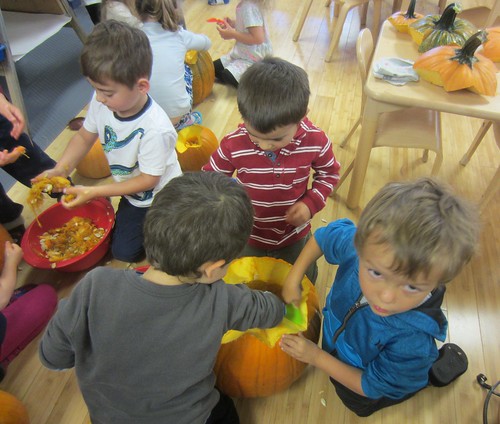





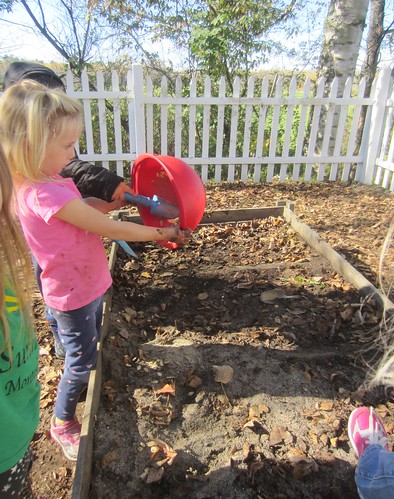
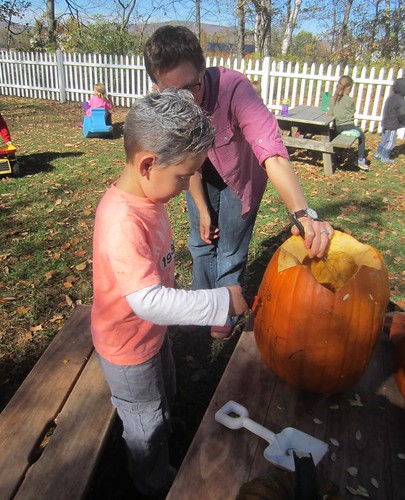
 Susan, who is our resident singer and musician, has enthusiastically volunteered to lead group music times. She began by reviewing high and low tones with the song, “There’s a Spider on the Floor.” When the spider was high on our heads, we sang in high pitched voices, and when it was low on the floor, we sang in low voices. Susan began teaching us about whole notes, half notes, and quarter notes. She showed us a long block, two blocks that equal one long block, and four blocks that equal the same length. She then led us in some clapping and marching to the count of four. We would march on one, two, three, four and clap on one and three.
Susan, who is our resident singer and musician, has enthusiastically volunteered to lead group music times. She began by reviewing high and low tones with the song, “There’s a Spider on the Floor.” When the spider was high on our heads, we sang in high pitched voices, and when it was low on the floor, we sang in low voices. Susan began teaching us about whole notes, half notes, and quarter notes. She showed us a long block, two blocks that equal one long block, and four blocks that equal the same length. She then led us in some clapping and marching to the count of four. We would march on one, two, three, four and clap on one and three.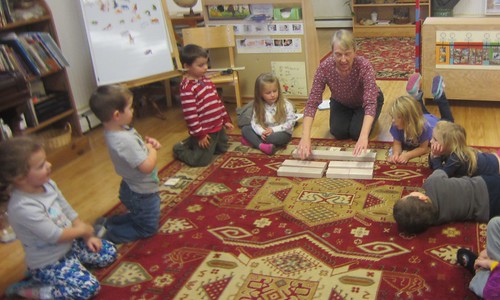
 For our second Spanish session with Zeanny we saw that the orugas (caterpillar) that went into the magic box last week had become la mariposa (butterfly). We played a game, passing la mariposa around the circle (like the hot potato song) then flying it around if we held it at the end. Zeanny began to teach us colors – verde (green), azule (blue), Amarillo (yellow), and roja (red). We also continued to work on the numbers from uno to diez.
For our second Spanish session with Zeanny we saw that the orugas (caterpillar) that went into the magic box last week had become la mariposa (butterfly). We played a game, passing la mariposa around the circle (like the hot potato song) then flying it around if we held it at the end. Zeanny began to teach us colors – verde (green), azule (blue), Amarillo (yellow), and roja (red). We also continued to work on the numbers from uno to diez.
 We celebrated a fourth birthday with our newest four year old. He smiled while walking through the seasons, taking the earth on it’s journey around the sun four times. He passed out cups of dirt and worms for everyone to snack on after the happy birthday song and blowing out the candle. Happy fourth Birthday!
We celebrated a fourth birthday with our newest four year old. He smiled while walking through the seasons, taking the earth on it’s journey around the sun four times. He passed out cups of dirt and worms for everyone to snack on after the happy birthday song and blowing out the candle. Happy fourth Birthday!

 To introduce an important lesson, that everyone makes mistakes and that they are opportunities to learn, we read the true story The Day Roy Riegels Ran the Wrong Way, when he did exactly as the title says, and ran for a touchdown to the wrong end zone during the 1929 Rose Bowl. (We had to do a little football lesson first, for those of us who don’t follow football). At the end of the story, after Roy had run across the field and stopped only 1 yard from the opposing teams end zone, finally realizing what he had done, he was very upset with himself. His coach, being a wise and supportive mentor, told him that mistakes are in the past, to let it go, learn from it, and don’t let it change the rest of the game. Roy Riegels took that advice, and played a great second half.
To introduce an important lesson, that everyone makes mistakes and that they are opportunities to learn, we read the true story The Day Roy Riegels Ran the Wrong Way, when he did exactly as the title says, and ran for a touchdown to the wrong end zone during the 1929 Rose Bowl. (We had to do a little football lesson first, for those of us who don’t follow football). At the end of the story, after Roy had run across the field and stopped only 1 yard from the opposing teams end zone, finally realizing what he had done, he was very upset with himself. His coach, being a wise and supportive mentor, told him that mistakes are in the past, to let it go, learn from it, and don’t let it change the rest of the game. Roy Riegels took that advice, and played a great second half.







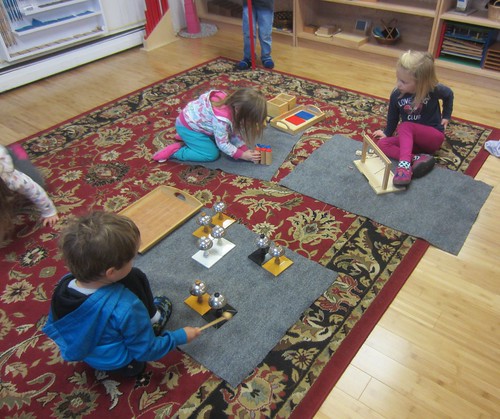
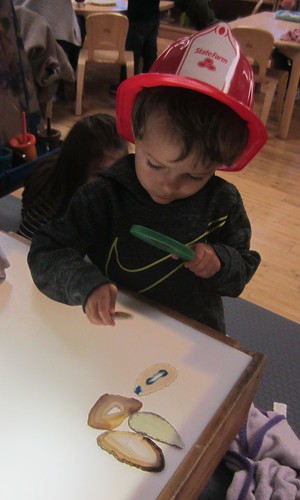



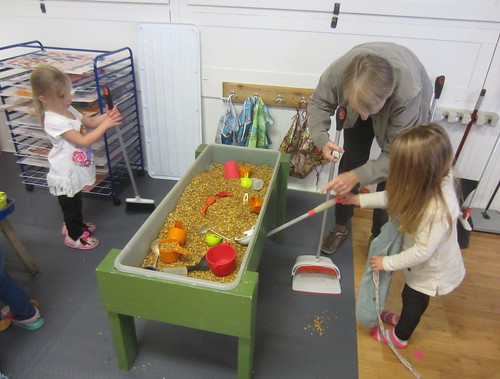








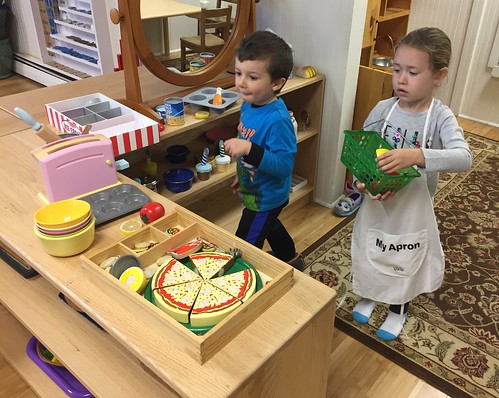




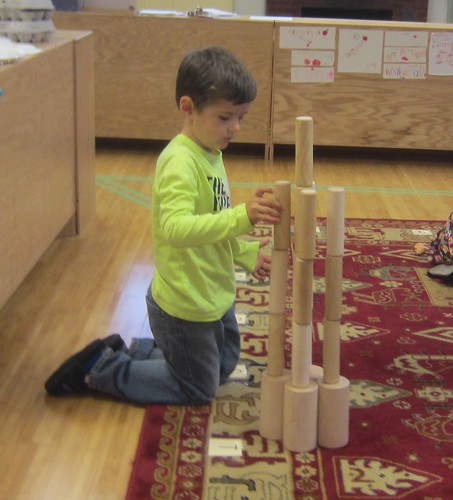




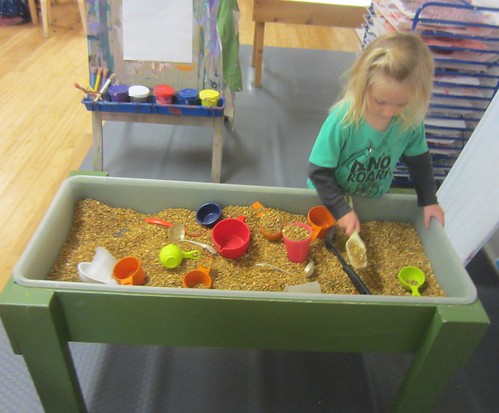

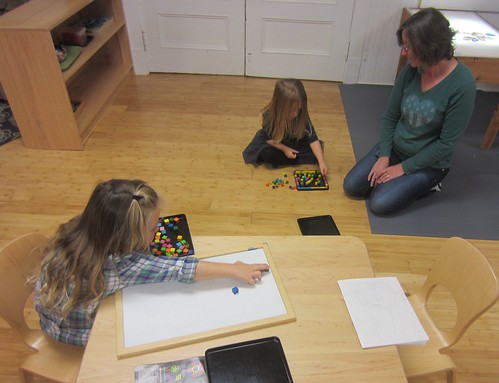



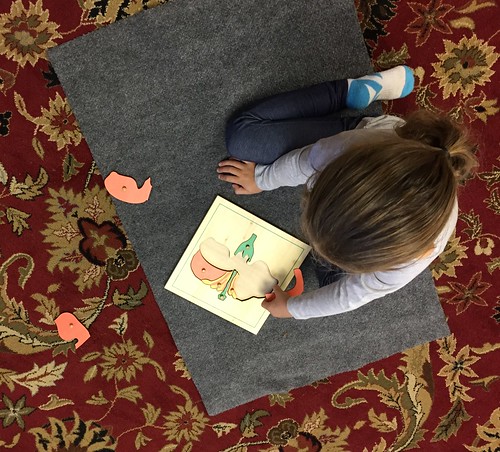





 Friday students reviewed how igneous rocks are formed – by lava or magma cooling in or above the earth, and sedimentary rocks – by layers and layers of rock, debris, sand, soil, etc. piling up and being pressed together into rock. This week we learned about metamorphic rocks, which are formed when other rocks are under heat and pressure, which morph, or change them, into new rocks. We watched a short video, then did an experiment with crushed ice. We agreed that if we made a ball of the ice and applied high heat, such as over a stove, it would melt, therefore becoming melted rock which would then turn into igneous rock. If our snowball was put under only pressure, such as being hit with a hammer, it would break into smaller pieces, turning it to sediment to become sedimentary rock. Finally, we made a snow ball that I held for a long time in my hands (it was very cold, so the children decided not to hold theirs) while applying steady pressure and heat from my hands. After several minutes, it was much more solid, compact, and melted together, just like a metamorphic rock.
Friday students reviewed how igneous rocks are formed – by lava or magma cooling in or above the earth, and sedimentary rocks – by layers and layers of rock, debris, sand, soil, etc. piling up and being pressed together into rock. This week we learned about metamorphic rocks, which are formed when other rocks are under heat and pressure, which morph, or change them, into new rocks. We watched a short video, then did an experiment with crushed ice. We agreed that if we made a ball of the ice and applied high heat, such as over a stove, it would melt, therefore becoming melted rock which would then turn into igneous rock. If our snowball was put under only pressure, such as being hit with a hammer, it would break into smaller pieces, turning it to sediment to become sedimentary rock. Finally, we made a snow ball that I held for a long time in my hands (it was very cold, so the children decided not to hold theirs) while applying steady pressure and heat from my hands. After several minutes, it was much more solid, compact, and melted together, just like a metamorphic rock.

Pumpkin Time
October 21, 2017
